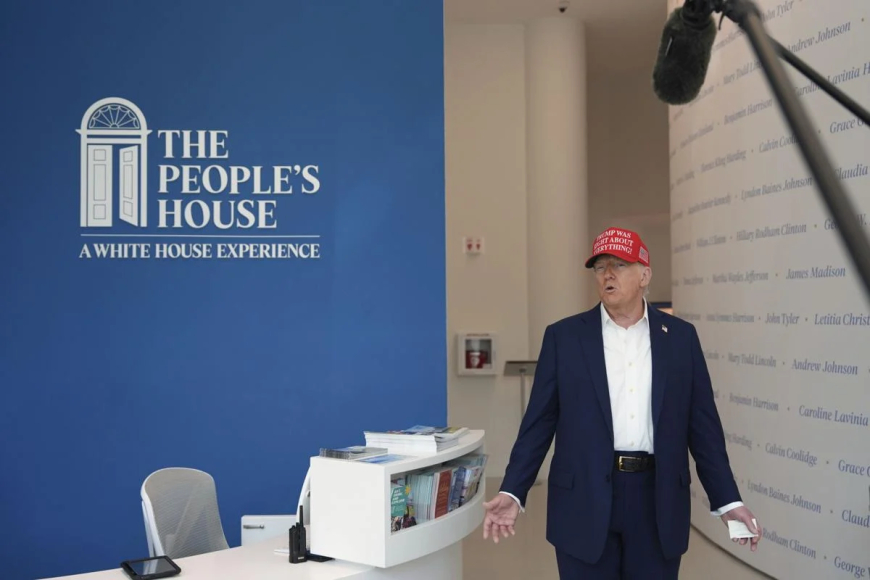Trump's Visit to 'The People’s House' Exhibit: Symbolism Amid Political Turmoil
President Trump visits The People’s House exhibit at the Smithsonian, blending history with political symbolism amid ongoing controversies. Explore behind-the-scenes insights, press exchanges, and cultural significance.

President Donald Trump’s surprise appearance at The People’s House exhibit inside the Smithsonian’s National Museum of American History was more than just a cultural stop. With reporters gathered for a brief gaggle, the visit carried symbolic weight, touching on themes of democracy, leadership, and presidential legacy, even as his administration faces intensifying political scrutiny.
A President, a Museum, and a Narrative
The People’s House exhibit, which highlights the White House’s evolving role as both a workplace and a national symbol, has long been a touchpoint for presidents seeking to reinforce their connection to American heritage. Trump’s visit on Saturday came at a time when his administration is navigating tensions over economic policies, civil unrest, and international diplomacy.
The president’s decision to engage with the press amid the exhibits — showcasing historical artifacts from Abraham Lincoln’s presidency to John F. Kennedy’s televised addresses — seemed designed to remind Americans of the continuity of the office, even during turbulent political climates.
“This house belongs to the people, and we are here to honor that tradition,” Trump remarked, standing before a display featuring Franklin D. Roosevelt’s fireside chats. His words echoed past presidents who used moments of historical reflection to frame their own leadership in the broader American story.
Historical Parallels: From Nixon to Reagan
Historians quickly drew comparisons between Trump’s visit and Richard Nixon’s 1970s tours of presidential libraries during Watergate. In both cases, analysts noted, presidents leaned on history to subtly defend their place in it. Others pointed to Ronald Reagan, who frequently invoked patriotic symbols during times of division to build confidence in the presidency.
Dr. Ellen Carmichael, a political historian at Georgetown University, observed:
“Moments like this are carefully curated. By visiting a cultural exhibit, Trump is simultaneously stepping into history and attempting to write his own chapter within it. The question is how much that symbolism resonates with a public deeply divided about his policies.”
The Gaggle: Press Questions and Controlled Messaging
During his brief gaggle with the press, Trump avoided direct engagement with ongoing legal challenges and instead steered the conversation toward themes of unity. When pressed about upcoming tariff negotiations with Canada and China, he deflected, noting, “This exhibit shows how every president has had challenges. The American people know history judges fairly.”
Critics argue that the carefully managed exchange reflected the administration’s strategy of controlling narratives while deflecting from immediate controversies. Supporters, however, viewed the visit as an affirmation of Trump’s resilience in the face of political headwinds.
Cultural Significance of The People’s House
The exhibit itself offers more than politics. Through multimedia displays, original furnishings, and interactive recordings, it highlights how the White House has shifted from an exclusive seat of power to a public space of symbolic democracy. For visitors, it is a reminder that presidents are temporary occupants of a larger historical continuum.
“The symbolism here cannot be overstated,” said curator Maria Henderson. “The White House is both an institution and a living symbol. Presidents use it to represent not just authority, but belonging to the people.”
This framing aligns with broader debates over whether presidential symbolism can bridge widening partisan divides.
Behind-the-Scenes: Footage and Staff Perspectives
Exclusive behind-the-scenes footage obtained from museum staff revealed Trump’s private tour included stops at sections rarely open to the public, such as early renderings of the White House during its post-1814 reconstruction. A staff member, speaking anonymously, noted:
“The president lingered longest at the Truman section, perhaps finding resonance in a leader who rebuilt both a house and a nation after war.”
Such moments offer rare insights into how sitting presidents interact with history not just for public consumption, but in private reflection.
The Broader Political Context
Trump’s visit occurred just days after a series of heated debates in Congress over federal intervention in major U.S. cities. Critics view the timing as calculated, an attempt to reframe media narratives from confrontational politics to cultural patriotism. Supporters argue that it underscores Trump’s commitment to reminding Americans of the endurance of their institutions.
For context, exhibits like The People’s House have historically been used by leaders to project messages of stability. Scholars point to the fact that cultural diplomacy — whether abroad or at home — often serves as a quiet form of political signaling.
Looking Ahead: Legacy and Memory
As Trump navigates both his presidency and his contested place in history, symbolic gestures like museum visits will likely continue to play a role in shaping public perception. The challenge lies in whether these moments can transcend political polarization and reinforce the very ideals they aim to celebrate.
The 2025 visit to The People’s House will be remembered less for policy announcements than for the cultural snapshot it provides: a president, amid political turmoil, seeking legitimacy in the enduring symbols of the nation’s democratic story.








